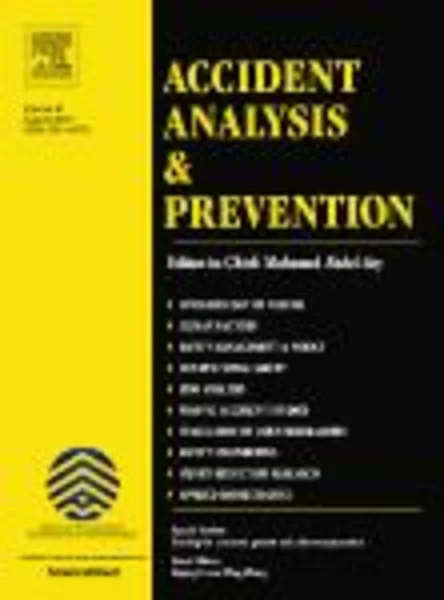-
age-related differences in street-crossing safety before and after training of older pedestrians
جزئیات بیشتر مقاله- تاریخ ارائه: 1392/01/01
- تاریخ انتشار در تی پی بین: 1392/01/01
- تعداد بازدید: 770
- تعداد پرسش و پاسخ ها: 0
- شماره تماس دبیرخانه رویداد: -
international accident statistics indicate that elderly pedestrians make up an extremely vulnerable road-user group. past research has shown that older adults make many unsafe street-crossing decisions and adopt insufficient safety margins, especially when vehicles are approaching at high speed. apart from studies on road design and speed-limit countermeasures, there is surprisingly no road-safety research on behavior-based measures to improve older pedestrians’ safety. in this line, the present study was aimed at (i) assessing the effectiveness of a training program for older pedestrians that combined behavioral and educational interventions, and (ii) examining whether and to what extent age-related differences in street-crossing safety could be reduced after training older adults. twenty seniors were enrolled in a training program. before, immediately after, and six months after training, street-crossing behavior was assessed using a simulated street-crossing task. twenty younger participants performed the same simulated task to obtain a baseline measure. the results showed that the training produced significant short- and long-term benefits, due to a shifting of the decision criteria among the older participants towards more conservative judgments. when compared with the younger group, the older participants improved their behavior considerably so that significant differences in the mean safety-related indicators were no longer observed. however, the older participants’ ability to take the oncoming car's speed into account did not improve. even after training, and contrary to younger adults, older participants were found to make more and more unsafe decisions as the car's speed increased, putting them at a higher risk at high speeds. this finding may reflect age-related perceptual and cognitive difficulties that cannot be remedied by a behavioral or educational training method. the present findings underline that high speed is an important risk factor for elderly pedestrians that should be handled by effective speed reduction measures (i.e. speed ramps, road narrowing).
مقالات جدیدترین رویدادها
-
استفاده از تحلیل اهمیت-عملکرد در ارائه الگوی مدیریت خلاقیت سازمانی و ارائه راهکار جهت بهبود
-
بررسی تاثیر ارزش وجوه نقد مازاد بر ساختار سرمایه شرکت های پذیرفته شده در بورس اوراق بهادار تهران
-
بررسی تأثیر سطح افشای ریسک بر قرارداد بدهی شرکت های پذیرفته شده در بورس اوراق بهادار تهران
-
بررسی تأثیر رتبه بندی اعتباری مبتنی بر مدل امتیاز بازار نوظهور بر نقد شوندگی سهام با تأکید بر خصوصی سازی شرکت ها
-
تأثیر آمیخته بازاریابی پوشاک ایرانی بر تصویر ذهنی مشتری پوشاک ایرانی (هاکوپیان)
-
پناهندگی ایرانیان در عتبات عالیات و تاثیر آن در مناسبات ایران و عثمانی؛ مطالعه موردی « شاهزادگان قاجاریه»
-
ارزیابی نقش شهرهای میانی در توسعه اقتصاد منطقه ای (مطالعه موردی شهر قشم)
-
بررسی رفتار ساختمان فولادی منظم با ایجاد حرکت گهواره ای در مهاربند با لینک قائم
-
مقایسه اندکس های اسپیرومتریک در دانشجویان پزشکی مذکر 23 تا 26 ساله دانشگاه علوم پزشکی زنجان با استانداردها
-
a novel heteropolyanion-based amino-containing cross-linked ionic copolymer catalyst for epoxidation of alkenes with h2o2
مقالات جدیدترین ژورنال ها
-
مدیریت و بررسی افسردگی دانش آموزان دختر مقطع متوسطه دوم در دروان کرونا در شهرستان دزفول
-
مدیریت و بررسی خرد سیاسی در اندیشه ی فردوسی در ادب ایران
-
واکاوی و مدیریت توصیفی قلمدان(جاکلیدی)ضریح در موزه آستان قدس رضوی
-
بررسی تاثیر خلاقیت، دانش و انگیزه کارکنان بر پیشنهادات نوآورانه کارکنان ( مورد مطالعه: هتل های 3 و 4 ستاره استان کرمان)
-
بررسی تاثیر کیفیت سیستم های اطلاعاتی بر تصمیم گیری موفق در شرکتهای تولیدی استان اصفهان (مورد مطالعه: مدیران شرکتهای تولیدی استان اصفهان)
-
اثربخشی درمان مثبت نگر بر کاهش علائم افسردگی و اضطراب در زنان باردار
-
تعیین کلی نقش واسطه ای بزهکاری همسالان در رابطه با فاکتورهای خانوادگی منفی با شدت مصرف مواد در دوران جوانی
-
تأثیر اجتناب از پرداخت مالیات بر معیارهای ارزیابی عملکرد مالی و سطح نگهداشت وجه نقد شرکت های پذیرفته شده در بورس اوراق بهادار تهران
-
یادداشتی بر رای شماره های 118 الی 120 هیئت عمومی دیوان عدالت اداری ( ابطال شرط تعهد کتبی مبنی بر 10 سال خدمت بدون قید و شرط در دفترچه راهنمای ثبت نام آزمون استخدامی )
-
an experimental study on behavior of sustainable rubberized concrete mixes




سوال خود را در مورد این مقاله مطرح نمایید :